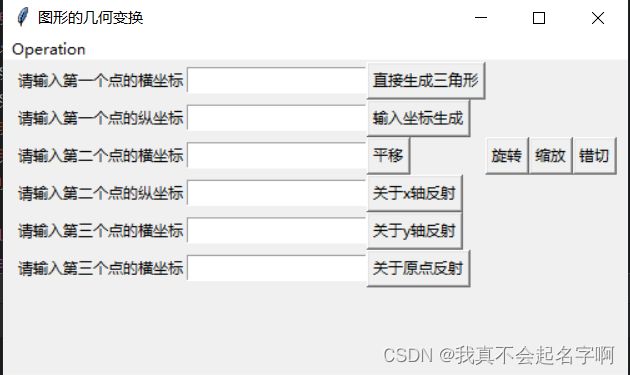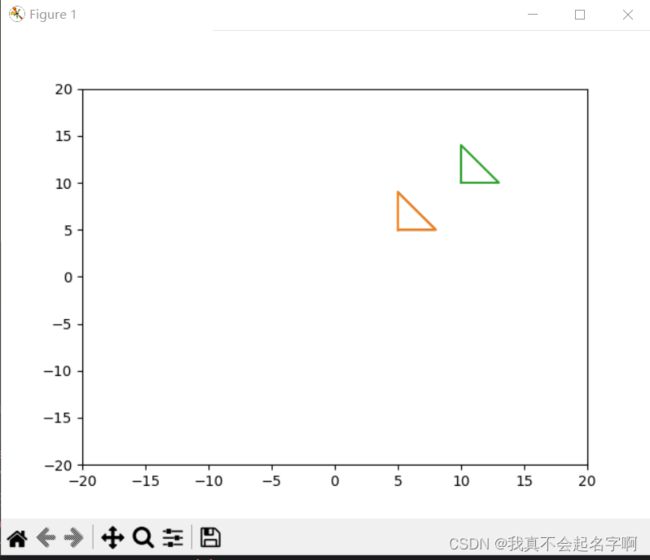Python实现图形的几何变换
一、能够提供对话框窗口,输入三角形的顶点坐标;或者,采用鼠标左键单击方式输入三角形的顶点坐标。
二、对输入的三角形顶点坐标进行五种基本几何变换:
- 对于平移变换,能够提供对话框窗口,输入平移向量;
- 对于旋转变换,能够提供对话框窗口,输入旋转角度,以逆时针为正;
- 对于缩放变换,能够提供对话框窗口,输入缩放因子;
- 对于错切变换,能够提供对话框窗口,输入错切系数;
- 对于反射变换,要求实现关于X轴、Y轴、原点的反射变换。
实现效果:
-
from tkinter import * import tkinter as tk import tkinter.simpledialog import math import matplotlib.pyplot as plt import tkinter.messagebox class CanvasDemo: def __init__(self): window=tk.Tk() window.title("3") window.geometry("500x250+500+300") frame=Frame(window) frame.pack() menubar=Menu(window) window.config(menu=menubar) operationMenu=Menu(menubar,tearoff=0) menubar.add_cascade(label="Operation",menu=operationMenu) self.entry_x1 = Entry(frame) self.entry_y1 = Entry(frame) self.entry_x2 = Entry(frame) self.entry_y2 = Entry(frame) self.entry_x3 = Entry(frame) self.entry_y3 = Entry(frame) Label(frame, text="请输入第一个点的横坐标").grid(row=1, column=0) Label(frame, text="请输入第一个点的纵坐标").grid(row=2, column=0) Label(frame, text="请输入第二个点的横坐标").grid(row=3, column=0) Label(frame, text="请输入第二个点的纵坐标").grid(row=4, column=0) Label(frame, text="请输入第三个点的横坐标").grid(row=5, column=0) Label(frame, text="请输入第三个点的横坐标").grid(row=6, column=0) self.entry_x1.grid(row=1, column=1) self.entry_y1.grid(row=2, column=1) self.entry_x2.grid(row=3, column=1) self.entry_y2.grid(row=4, column=1) self.entry_x3.grid(row=5, column=1) self.entry_y3.grid(row=6, column=1) btSan=Button(frame,text="直接生成三角形",command=self.displaySan).grid(row=1,column=3,sticky=W) btDrawSan=Button(frame,text="输入坐标生成",command=self.DrawSan).grid(row=2, column=3,sticky=W) translate_button = Button(frame, text="平移", command=self.translate).grid(row=3,column=3,sticky=W) rotate_button = Button(frame, text="旋转", command=self.rotate).grid(row=3,column=4,sticky=W) scale_button = Button(frame, text="缩放", command=self.scale).grid(row=3, column=5,sticky=W) shear_button = Button(frame, text="错切", command=self.shear).grid(row=3, column=6,sticky=W) reflectx_button = Button(frame, text="关于x轴反射", command=self.reflectx).grid(row=4, column=3, sticky=W) reflecty_button = Button(frame, text="关于y轴反射", command=self.reflecty).grid(row=5, column=3, sticky=W) reflectxy_button = Button(frame, text="关于原点反射", command=self.reflectxy).grid(row=6, column=3, sticky=W) operationMenu.add_command(label="关于x轴反射",command=self.reflectx) operationMenu.add_command(label="关于y轴反射", command=self.reflecty) operationMenu.add_command(label="关于原点反射", command=self.reflectxy) window.mainloop() def displaySan(self): x = [5,8,5,5] y = [5,5,9,5] plt.plot(x, y) plt.xlim(-20, 20) plt.ylim(-20, 20) plt.show() def DrawSan(self): try: x1 = int(self.entry_x1.get()) y1 = int(self.entry_y1.get()) x2 = int(self.entry_x2.get()) y2 = int(self.entry_y2.get()) x3 = int(self.entry_x3.get()) y3 = int(self.entry_y3.get()) x=[x1,x2,x3,x1] y=[y1,y2,y3,y1] plt.plot(x,y) plt.xlim(-20, 20) plt.ylim(-20,20) plt.show() except ValueError: tkinter.messagebox.showerror("错误","请输入有效数字") def translate(self): x = tk.simpledialog.askinteger("平移","请输入x方向的平移向量") y = tk.simpledialog.askinteger("平移","请输入y方向的平移向量") x1 = int(self.entry_x1.get()) y1 = int(self.entry_y1.get()) x2 = int(self.entry_x2.get()) y2 = int(self.entry_y2.get()) x3 = int(self.entry_x3.get()) y3 = int(self.entry_y3.get()) xc = [x1, x2, x3, x1] yd = [y1, y2, y3, y1] cx1=x1+x cx2=x2+x cx3=x3+x cy1=y1+y cy2=y2+y cy3=y3+y x_=[cx1,cx2,cx3,cx1] y_=[cy1,cy2,cy3,cy1] plt.plot(xc, yd) plt.plot(x_,y_) plt.xlim(-20, 20) plt.ylim(-20, 20) plt.show() def rotate(self): angle = tk.simpledialog.askinteger("旋转", "请输入旋转角度") x1 = int(self.entry_x1.get()) y1 = int(self.entry_y1.get()) x2 = int(self.entry_x2.get()) y2 = int(self.entry_y2.get()) x3 = int(self.entry_x3.get()) y3 = int(self.entry_y3.get()) angle_rad = math.radians(angle) cos_val = math.cos(angle_rad) sin_val = math.sin(angle_rad) new_x1 = x1 * cos_val - y1 * sin_val new_y1 = x1 * sin_val + y1 * cos_val new_x2 = x2 * cos_val - y2 * sin_val new_y2 = x2 * sin_val + y2 * cos_val new_x3 = x3 * cos_val - y3 * sin_val new_y3 = x3 * sin_val + y3 * cos_val x=[x1,x2,x3,x1] y=[y1,y2,y3,y1] xc=[new_x1,new_x2,new_x3,new_x1] yd=[new_y1,new_y2,new_y3,new_y1] plt.plot(xc, yd) plt.plot(x,y) plt.xlim(-20, 20) plt.ylim(-20, 20) plt.show() def scale(self): x_scale = tk.simpledialog.askfloat("缩放", "请输入x方向的缩放因子") y_scale = tk.simpledialog.askfloat("缩放", "请输入y方向的缩放因子") x1 = int(self.entry_x1.get()) y1 = int(self.entry_y1.get()) x2 = int(self.entry_x2.get()) y2 = int(self.entry_y2.get()) x3 = int(self.entry_x3.get()) y3 = int(self.entry_y3.get()) new_x1 = x1 * x_scale new_y1 = y1 * y_scale new_x2 = x2 * x_scale new_y2 = y2 * y_scale new_x3 = x3 * x_scale new_y3 = y3 * y_scale x = [x1, x2, x3, x1] y = [y1, y2, y3, y1] xc = [new_x1, new_x2, new_x3, new_x1] yd = [new_y1, new_y2, new_y3, new_y1] plt.plot(xc, yd) plt.plot(x, y) plt.xlim(-20, 20) plt.ylim(-20, 20) plt.show() def shear(self): shear_b = tk.simpledialog.askfloat("错切", "请输入x方向错切系数b") shear_d = tk.simpledialog.askfloat("错切", "请输入y方向错切系数d") x1 = int(self.entry_x1.get()) y1 = int(self.entry_y1.get()) x2 = int(self.entry_x2.get()) y2 = int(self.entry_y2.get()) x3 = int(self.entry_x3.get()) y3 = int(self.entry_y3.get()) new_x1 = x1 +shear_b*y1 new_y1 = y1 +shear_d*x1 new_x2 = x2 +shear_b*y2 new_y2 = y2 +shear_d*x2 new_x3 = x3 +shear_b*y3 new_y3 = y3 +shear_d*x3 x = [x1, x2, x3, x1] y = [y1, y2, y3, y1] xc = [new_x1, new_x2, new_x3, new_x1] yd = [new_y1, new_y2, new_y3, new_y1] plt.plot(xc, yd) plt.plot(x, y) plt.xlim(-20, 20) plt.ylim(-20, 20) plt.show() def reflectx(self): x1 = int(self.entry_x1.get()) y1 = int(self.entry_y1.get()) x2 = int(self.entry_x2.get()) y2 = int(self.entry_y2.get()) x3 = int(self.entry_x3.get()) y3 = int(self.entry_y3.get()) y1_reflect =-y1 y2_reflect =-y2 y3_reflect =-y3 x = [x1, x2, x3, x1] y = [y1, y2, y3, y1] xc = [x1, x2, x3, x1] yd = [y1_reflect,y2_reflect,y3_reflect,y1_reflect] plt.plot(xc, yd) plt.plot(x, y) plt.xlim(-20, 20) plt.ylim(-20, 20) plt.show() def reflecty(self): x1 = int(self.entry_x1.get()) y1 = int(self.entry_y1.get()) x2 = int(self.entry_x2.get()) y2 = int(self.entry_y2.get()) x3 = int(self.entry_x3.get()) y3 = int(self.entry_y3.get()) x1_reflect = -x1 x2_reflect = -x2 x3_reflect = -x3 x = [x1, x2, x3, x1] y = [y1, y2, y3, y1] xc = [x1_reflect,x2_reflect,x3_reflect,x1_reflect] yd = [y1, y2, y3, y1] plt.plot(xc, yd) plt.plot(x, y) plt.xlim(-20, 20) plt.ylim(-20, 20) plt.show() def reflectxy(self): x1 = int(self.entry_x1.get()) y1 = int(self.entry_y1.get()) x2 = int(self.entry_x2.get()) y2 = int(self.entry_y2.get()) x3 = int(self.entry_x3.get()) y3 = int(self.entry_y3.get()) x1_reflect = -x1 x2_reflect = -x2 x3_reflect = -x3 y1_reflect = -y1 y2_reflect = -y2 y3_reflect = -y3 x = [x1, x2, x3, x1] y = [y1, y2, y3, y1] xc = [x1_reflect,x2_reflect,x3_reflect,x1_reflect] yd = [y1_reflect,y2_reflect,y3_reflect,y1_reflect] plt.plot(xc, yd) plt.plot(x, y) plt.xlim(-20, 20) plt.ylim(-20, 20) plt.show() CanvasDemo()





